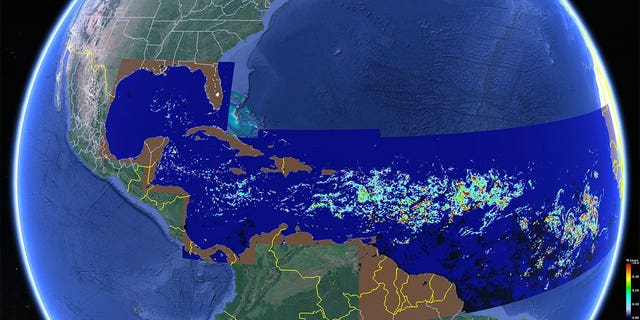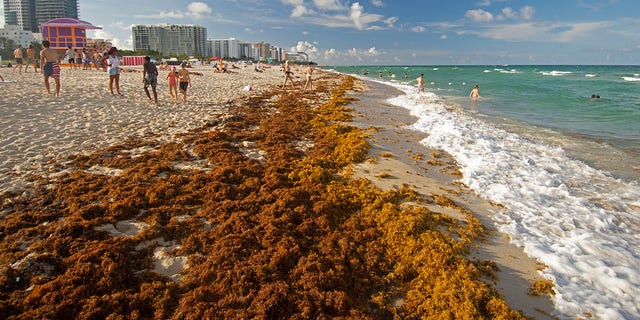Satellite images show breadth of massive seaweed belt stretching across the Atlantic Ocean
Satellite images show a train of sargassum seaweed stretching from the west coast of Africa to Florida, stretching as far as 5,000 miles.
With a width of nearly twice that of the U.S., the seaweed is expected to move toward Florida and the Caribbean, ultimately piling up along some of the most beautiful beaches in the world.
According to the National Oceanic and Atmospheric Administration, or NOAA, Sargassum is a large brown seaweed that “floats in island-like masses,” yet never attaches to the bed of the sea.
GIANT BLOB OF SEAWEED TWICE THE WIDTH OF US TAKING AIM AT FLORIDA, SCIENTISTS SAY
Images on the University of South Florida College of Marine Science Optical Oceanography Laboratory website shows the massive size of the bloom.
The Sargassum Watch System, or SaWS, uses satellite data and models to track sargassum in “near-real time.

While sargassum offers a great habitat for marine animals because of its source of food, shade and shelter, it also can be used to protect sand dunes by fertilizing and strengthening the grassroots.
CLIMATE ACTIVISTS, DEMS TURN ON BIDEN OVER LIKELY ALASKAN OIL DRILLING PROJECT: ‘AN EXISTENTIAL THREAT’
But when copious amounts of sargassum piles up on the beaches, it has the potential of causing many problems.
The university website says when sargassum decomposes, it can create a bad stench that attracts bugs and can smother turtle nests, among other things.
The bugs and the smell can also hurt tourism, impacting economics of tropical locations.

Many times, the sargassum, when piled up in enormous amounts, must physically be removed from the beaches.
MASSIVE SMELLY ALGAE BLOOM NEARING FLORIDA WILL IMPACT HEALTH OF RESIDENTS
As the bloom moves toward the coast, some Floridians have complained about burning eyes and breathing problems. Dead fish have washed up and a beachside festival scheduled a month away was canceled.
The southwest coast of Florida experienced a toxic red tide algae earlier this month, sparking concerns it could stick around for a while.
Red tide naturally occurs in the Gulf of Mexico and is oftentimes made worse by humans because of the presence of nutrients like nitrogen in the water.
People are advised to not swim in red tide waters because of respiratory issues as well as skin irritation, rashes and sore eyes.
Bradford Betz of Fox News Digital contributed to this report.
Read the full article Here


